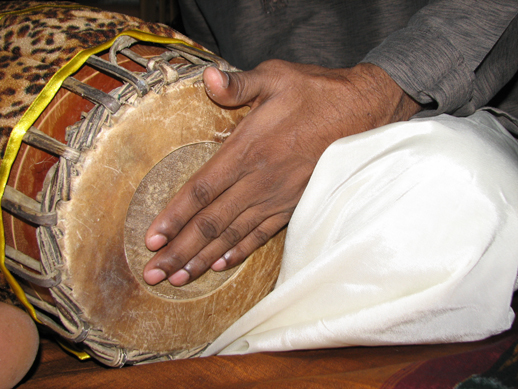PROGRAM DETAILS Playing Techniques The course explores through a detailed study of everything pertaining to the proper techniques of playing Mridangam right from the sitting posture and holding the instrument to the use of hands and fingers. The lessons contain drum syllables set to Adi talam which is nothing but an 8-beat cycle of a steady rhythmic structure. Students are taught appropriate limb/finger movements, use of wrist action, developing 'muscle-memory', singificance of balance and coordination, hard/soft touch and sound-sensitivity, etc. The Regular course leads to examination at 3 levels, Standard, Intermediate and
Advanced. Playing Mridangam for a solo performance, ensemble, as an accompaniment for
concerts and as a percussionist for dance performances. alapana Mridangam classes as an
ancillary subject will prepare the student for the other core classes and also for
all performance-oriented classes.
Drum syllables in lessons Students are taught the various drum syllables used in South Indian music. In native terms, they are called the Jatis or Sol-Kattu or Konnakkol. The drum syllables are in a way tongue-twisters. If these drum syllables are said orally with proper articulation and breath control, they sound great. While learning them you get to know the execution of the tala (Rhythmic yardstick with
hand gestures). The simple notated representation using English alphabets also improves
one's Sight-reading abilities. The 3 months' course that answers the question, "What we do on the drums can we do orally?" The student will learn important theory information and the practical application of reading in various styles. The course includes ear training, sight reading drill, and intricate tala exercises. The class assembles once a week for one hour of interactive learning and Towards the end of the course, thereawill be a performance based project presentation by the participants. Course leads to a certificate.
Ensemble Workshops These are performance-oriented classes that focus on group interaction,
timekeeping, reading and the recognition and understanding of notated version of ensemble
scripts with stylistic interpretation. The students are taught the orchestral pieces after
the basics of the Ragas contained in them is covered. This will improve their
understanding and performance in a group.
Studio Music Technique Course deals with the conditions of the studio workplace. Students are taught mic-sense and special attention to studio environment. There will be special emphasis to teach the presentation skills for best recording results. Includes trial recording and final project performance to audio record their own performance.Accompanying musicians will be arranged for recording. The successful candidate will cut an audio CD master at alapana of his/her performance recorded at alapana. Students are also taught about the interaction of producer, songwriter, engineer, etc., in the music making process. Guru(Instructor): Mr V.Raghuraman
Exposure to Percussion instruments of India for Drummers This is a "hands on" course that introduces the drummer to the variety of hand percussion instruments of India in the classical stream. Students are taught the basics of Mridangam and Tabla. A secondary focus is on Ghatam , Kanjira, Mohrsing, Dolak & Naal. The student is taught basic techniques on the various instruments in order to combine with other students and perform in ensemble settings. In the process they will also be able to grasp the elements of similarities and differences in North and South Indian percussion approach. Guru(Instructor)s: Mr V.Raghuraman
& Mr Jatinder Singh Private Lesson A one-on-one meeting once a week with an instructor to work on the curriculum, trouble-shoot problem areas and offer an opportunity to evaluate student progress. The venue will be alapana classrooms.
NAC-AEP School Programmes (applicable to Singapore schools) As per NAC-AEP 2007-08 approved courses of alapana. These programmes are conducted in various schools of Singapore.
Theory of Indian Music The Theory class is a combination of lecture and demonstration to assure the student that he/she has acquired a comprehensive knowledge of the fundamentals of Indian Music theory. Topics covered are: History of Indian Music, Evolution of the Raga system, Development of musical instruments, Trinity of Carnatic music, Tala system, Pitch, Notation, Structure of compositions, Concert tradition, Glossary of terms, Do's & Dont's. Guru (Instructor)s: Mrs R.Banumathy & Mr V.Raghuraman
Studio Recording Workshop The Studio Recording Workshop is designed to give the student hands on experience inside a working alapana recording studio. The course is currently under review for launch. (to be launched shortly)
|
 Tha Played with the four fingers falling flat on the inner skin of the Thoppi
Thi Played with the four fingers falling flat on the black patch of the Valanthalai
Thom Played with the four fingers striking at the side of the Thoppi such that the inner skin is free to vibrate.(The white paste at the centre is a small quantity semolina dough. Much of the bass 'Thom' sound is due to this)
Nam Played with the index finger striking the outer layer of skin (Vettu Thattu) on the Valanthalai
Ki Played with the three fingers (other than the index finger) falling flat on the Sadam (black patch) on the Valanthalai
Ta Played with the the index finger falling sharp at the Sadam (black patch) on the Valanthalai
Chapu Played with the little finger with its tip firmly striking the periphery of the Sadam (black patch) at 9 o'clock position to obtain a string-like sound that denotes the pitch.
Arai Chapu Another type of Chapu played across the the Sadam (black patch) at almost 3 o'clock position.
Sitting posture Sri Karaikudi R.Mani |
| home © Copyright 2006 alapana Centre for Music and Dance :: All rights reserved alapana Centre for Music and Danc | 375 Serangoon Road | Singapore 218122 Tel: (65) 63963296 or (65) 98280418 |